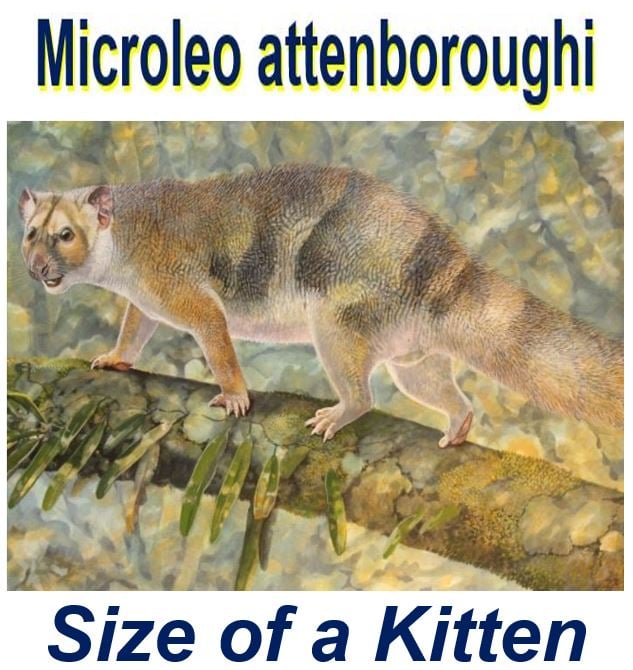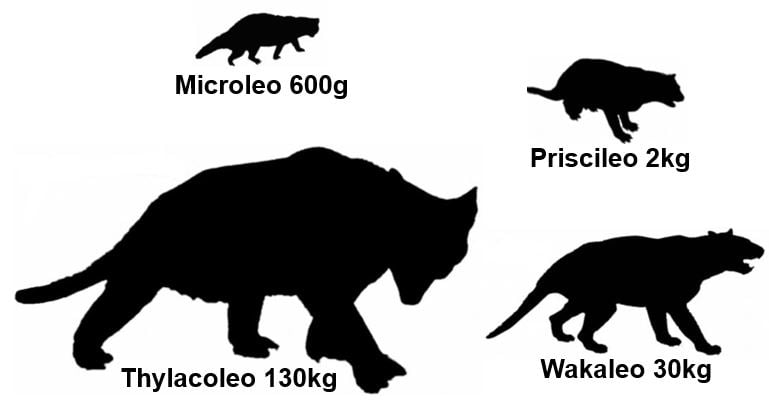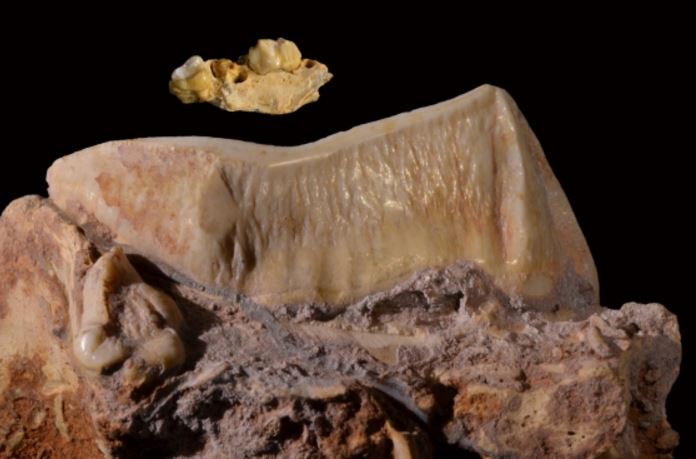A tiny, kitten-sized marsupial lion that lived in northern Australia about 18 million years ago has been named after the famous broadcaster and naturalist Sir David Attenborough. Scientists found fossil remains of the new species, called Microleo attenboroughi, in the Riversleigh World Heritage Area, in the north west of Queensland.
The discovery team, from the University of New South Wales (UNSW) said the new species’ name was in recognition for Sir David’s support for the Riversleigh World Heritage Area, which he claims is one of the four most important fossil regions globally.
The new species was considerably smaller than the other members of this extinct marsupial lion family, including Thylacoleo carnifex, its lion-sized younger relative.
 Reconstruction of Microleo attenboroughi prowling along the branches of rainforest trees in search of prey. (Image: unsw.edu.au. Credit: Peter Schouten)
Reconstruction of Microleo attenboroughi prowling along the branches of rainforest trees in search of prey. (Image: unsw.edu.au. Credit: Peter Schouten)
Dr. Anna Gillespie, a technical researcher at UNSW’s School of Biological, Earth and Environmental Sciences, and colleagues wrote about their discovery in the journal Palaeontologia Electronica.
Lead author, Dr. Gillespie, said:
“Microleo attenboroughi would have been more like the cute but still feisty kitten of the family. It was not lion-size or even bob-cat-size. Weighing only about 600 grams, it was more like a ringtail possum in size.”
The scientists discovered fossil specimens of part of the animal’s skull and teeth. Its dentition includes an elongate, ultra-sharp, knife-like premolar in front of basined molars. These specialised features have been observed in all members of this amazing family of marsupial carnivores, the Thylacoleonidae.
Fossil specimens were recovered from a limestone deposit that the authors believe had formed in a pool within a rainforest landscape during the Miocene, approximately 19 million years ago.
 Microleo attenboroughi was considerably smaller than the three other genera of marsupial lions, Priscileo, Wakaleo and Thylacoleo. (Image: unsw.edu.au)
Microleo attenboroughi was considerably smaller than the three other genera of marsupial lions, Priscileo, Wakaleo and Thylacoleo. (Image: unsw.edu.au)
The fossil deposit – Neville’s Garden Site – has already revealed abundant fauna, including several kinds of possums and kangaroos, diminutive koalas, thousands of bats, six different kinds of bandicoots, turtles, lizards, fish, pythons, storks, logrunners, and the earliest-known Australian parrot.
Co-author, Professor Mike Archer, who also works at UNSW’s School of Biological, Earth and Environmental Sciences, said:
“Despite its relatively small size compared with the Pleistocene Thylacoleo carnifex – the last surviving megafaunal marsupial lion – the new species was one of the larger flesh-eaters existing in its ancient community of rainforest creatures at Riversleigh.”
Riversleigh has a diversity of marsupial lion specimens seen nowhere else on the continent.
 Compare the tiny tooth row of Microleo attenboroughi with the tooth row of its Pleistocene relative, the lion-sized Thylacoleo carnifex. (Image: unsw.edu.au)
Compare the tiny tooth row of Microleo attenboroughi with the tooth row of its Pleistocene relative, the lion-sized Thylacoleo carnifex. (Image: unsw.edu.au)
Dr. Gillespie said:
“Microleo shared these northern Miocene rainforests with two larger species of marsupial lion, one cat-sized and the other dog-sized. Although it is possible they competed with one other, the size differences probably means they each specialised on a different size range of prey.”
“It’s likely that Microleo scampered amongst the tree-tops, gobbling insects as well as small vertebrates such as lizards and birds while simultaneously trying to avoid becoming a prey item for its larger relatives.”
Co-author, Professor Suzanne Hand, said:
“The early Miocene of northern Australia, as documented by the thousands of fossils from Riversleigh, was a time of mild, very wet climatic conditions with mammal diversity more like that seen in Borneo than anywhere in Australia today.”
While thousands of bones and teeth have been unearthed in the four decades of research at Riversleigh, only one specimen of this tiny flesh-eater has been recovered.
Prof. Archer said:
“Tantalising questions about the rest of its skull and skeleton which could further clarify aspects of its lifestyle – such as whether it had an enlarged ‘killing’ thumb claw like its Pleistocene relative – must await discovery of more complete specimens.”
Citation: “A tiny new marsupial lion (Marsupialia, Thylacoleonidae) from the early Miocene of Australia,” Anna K. Gillespie, Michael Archer, and Suzanne J. Hand. Palaeontologia Electronica. Article Number 19.2.26A. July 2016.
